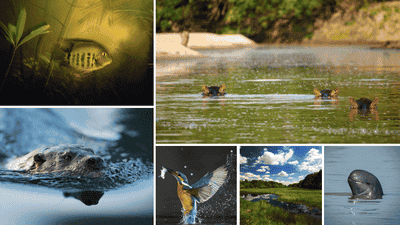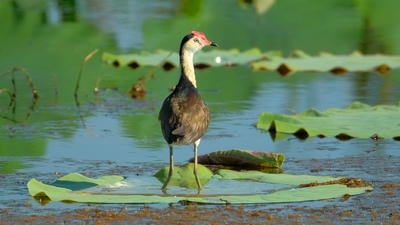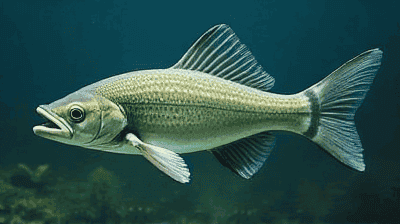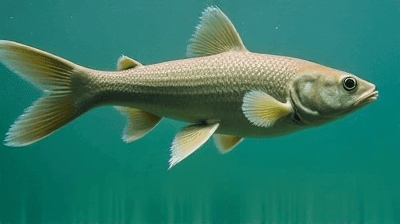
Freshwater ecosystems, which include rivers, lakes, wetlands, and streams, are critical to the functioning of our planet. They provide vital resources for humans, support diverse wildlife, and help regulate local climates. However, these ecosystems are not only under threat; they are experiencing an unprecedented crisis. Freshwater species are disappearing at an alarming rate—twice as fast as their terrestrial and marine counterparts. Understanding the causes and consequences of this hidden crisis is essential for conservation efforts aimed at preserving freshwater biodiversity.
Freshwater ecosystems are home to an incredible wealth of biodiversity. They support approximately 10 percent of all known species on Earth, despite covering only about 1 percent of the planet’s surface. This includes a wide variety of taxa, such as fish, amphibians, insects, and plants.
Fish Species: Freshwater fish alone constitute more than 40 percent of the world's fish species, with many of them exhibiting unique adaptations and behaviors.
Endemic Species: Many freshwater species are endemic, meaning they are found nowhere else on Earth. This makes their conservation all the more urgent.
Freshwater ecosystems provide critical ecosystem services that benefit humans and wildlife alike:
Water Supply: Rivers and lakes serve as sources of drinking water, irrigation for agriculture, and industrial uses.
Flood Regulation: Wetlands function as natural buffers, absorbing excess water during floods and helping to mitigate flooding impacts.
Water Filtration: Freshwater ecosystems play a vital role in filtering pollutants from water, improving water quality for ecosystems and human communities.
Recreation and Tourism: Freshwater environments provide opportunities for recreational activities such as fishing, swimming, and boating, contributing to local economies.
Freshwater ecosystems help regulate local and regional climates. They influence precipitation patterns, support local weather systems, and provide cooling effects in urban areas.

Recent studies indicate that freshwater species are disappearing at a rate nearly double that of terrestrial and marine species. According to the World Wildlife Fund, freshwater species populations have declined by an average of 76 percent between 1970 and 2016.
Although all freshwater taxa are under threat, some groups are particularly vulnerable:
Fish: Overfishing, habitat degradation, and pollution have led to significant declines in freshwater fish populations.
Amphibians: Many amphibian species rely on specific freshwater habitats for breeding and development, making them particularly susceptible to habitat loss.
Invertebrates: Freshwater invertebrates, such as snails and aquatic insects, are critical components of food webs but are facing steep declines due to pollution and habitat destruction.
The decline of freshwater species is not uniform across the globe. Certain regions are experiencing more acute losses due to unique environmental and anthropogenic pressures.
Tropical Freshwater Ecosystems: These regions often host high levels of biodiversity but also face significant threats from deforestation, agriculture, and urbanization.
Developed Regions: Intensive agricultural practices and urban sprawl in developed countries are major contributors to freshwater species decline, impacting both water quality and habitat availability.
One of the most significant drivers of freshwater species decline is the destruction of their habitats. Human activities are primarily responsible for altering and destroying these ecosystems.
Dams and Water Diversion: The construction of dams alters natural water flows, disrupts sediment transport, and can fragment habitats, making it difficult for species to thrive.
Urban Development: Expanding cities encroach on freshwater habitats, leading to pollution and habitat fragmentation. Runoff from urban areas often carries contaminants that degrade water quality.
Agricultural Expansion: Intensified agricultural practices result in the conversion of wetlands and floodplains into farmland, drastically altering the natural landscape.
Water pollution is a widespread issue that significantly impacts freshwater species.
Nutrient Runoff: Excessive use of fertilizers in agriculture results in nutrient runoff, leading to eutrophication—prompting harmful algal blooms that deplete oxygen levels, harming aquatic life.
Chemical Contaminants: Pesticides, heavy metals, and pharmaceuticals enter freshwater systems through runoff and wastewater, adversely affecting the health and survival of aquatic organisms.
Microplastics: The proliferation of microplastics in water bodies poses a new threat to freshwater species, as these pollutants can be ingested by aquatic organisms, causing physical and toxicological harm.
Climate change exacerbates existing pressures on freshwater ecosystems, highlighting its impacts on species decline.
Altered Hydrology: Changes in precipitation patterns and increased evaporation rates can lead to altered streamflows and reduced water availability for freshwater species.
Temperature Changes: Warmer water temperatures can disrupt breeding cycles and physiological processes in freshwater species, particularly cold-water fish.
Invasive Species: Climate change can facilitate the spread of invasive species, which compete with native organisms for resources, often leading to population declines or extinctions.
Overfishing and unsustainable harvesting practices threaten the survival of many freshwater species.
Declines in Fish Populations: Overfishing has led to significant declines in the populations of many freshwater fish species, pushing them closer to extinction.
Unsustainable Practices: The illegal collection of freshwater organisms, such as mollusks and aquatic plants, can lead to rapid declines that disrupt ecosystems.

The decline of freshwater species results in a significant loss of overall biodiversity. This not only diminishes the richness of life but also affects the resilience and functioning of ecosystems.
As freshwater species decline, the ecosystem services they provide are jeopardized. Key implications include:
Water Quality Degradation: The loss of filter-feeding organisms can lead to poorer water quality, affecting both ecosystems and human populations.
Altered Food Webs: The disappearance of key species disrupts food webs, resulting in imbalances that can affect predator and prey populations alike.
The decline of freshwater biodiversity has direct implications for human communities that rely on these ecosystems:
Fishing Communities: Declining fish populations impact livelihoods and food security for millions of people who depend on fishing for sustenance and income.
Recreation and Tourism: Freshwater species decline can deter tourism in regions that rely on outdoor recreation, impacting local economies.
Freshwater ecosystems hold cultural significance for many communities, particularly Indigenous peoples. The loss of species and the degradation of habitats can erase traditional practices and cultural identities associated with these environments.
Establishing protected areas is a critical strategy for conserving freshwater ecosystems and the species that inhabit them:
Wetland Protection: Guarding wetlands from development and pollution can provide essential habitat for many freshwater species and support biodiversity.
Connectivity: Ensuring that protected areas are well-connected facilitates species movement and helps maintain genetic diversity.
Promoting sustainable agricultural and urban development practices is essential to reducing the impacts of habitat destruction and pollution:
Agroecology: Implementing agroecological practices can enhance water quality and reduce runoff while supporting biodiversity.
Low-Impact Development: Designing urban areas with permeable surfaces and green infrastructure can mitigate stormwater runoff and protect freshwater habitats.
Addressing pollution is vital for improving freshwater ecosystem health:
Stormwater Management: Implementing effective stormwater management practices can reduce nutrient and contaminant runoff into freshwater systems.
Industrial Regulations: Stricter regulations on industrial discharges can help safeguard freshwater ecosystems from toxic pollutants.
Restoration initiatives play a crucial role in recovering degraded freshwater habitats and improving ecosystem resilience:
Wetland Restoration: Restoring wetlands can enhance water filtration, flood control, and critical habitats for biodiversity.
River Rehabilitation: Projects aimed at restoring natural river flows, removing dams, or enhancing riparian zones can revitalize freshwater ecosystems.
Raising awareness about the importance of freshwater ecosystems and the threats they face is essential for fostering support for conservation efforts:
Community Involvement: Engaging local communities in conservation initiatives and restoration projects facilitates stewardship and promotes sustainable practices.
Education Programs: Environmental education programs can foster a deeper understanding of freshwater ecosystems and the crucial role they play in supporting life on Earth.

The rapid decline of freshwater species is a pressing crisis that demands immediate attention. As ecosystems face multiple threats—from habitat destruction to pollution and climate change—the urgency for effective conservation and restoration strategies has never been greater. Freshwater ecosystems are not merely important because they support biodiversity; they are vital for human survival, providing essential ecosystem services and sustaining cultural identities.
Addressing this hidden crisis requires a multifaceted approach that encompasses habitat protection, pollution mitigation, sustainable land use practices, and public engagement. By prioritizing freshwater ecosystems and the species that inhabit them, we can ensure the resilience and function of these critical environments for future generations.
The time to act is now. As stewards of our planet, we must commit to preserving the rich biodiversity of freshwater ecosystems, understanding that their survival is intricately linked to our own well-being. Together, we can forge a path toward restoring and protecting the hidden treasures of our freshwater environments.